Как стартапам следует выстроить маховик роста от продукта к сообществу?
Оригинальный автор: Joel John Siddharth
Оригинальный перевод: TechFlow
Today’s story is a continuation of the past few stories. In my last installment, I mentioned that people, not presentations , determine the results of a company, with a special emphasis on the role of the founder.
Today’s story focuses on users. I’ll explore how a company nurtures its community over a decade, and why founders should focus on their community to achieve scale.
This is a prelude to a series of articles we’re doing with several Chief Marketing Officers (CMOs). Over the next month, I’ll be speaking with senior leaders at multiple protocols to learn how they’re building communities. My goal is to build a series of stories that can guide founders in their direction as they build their companies.
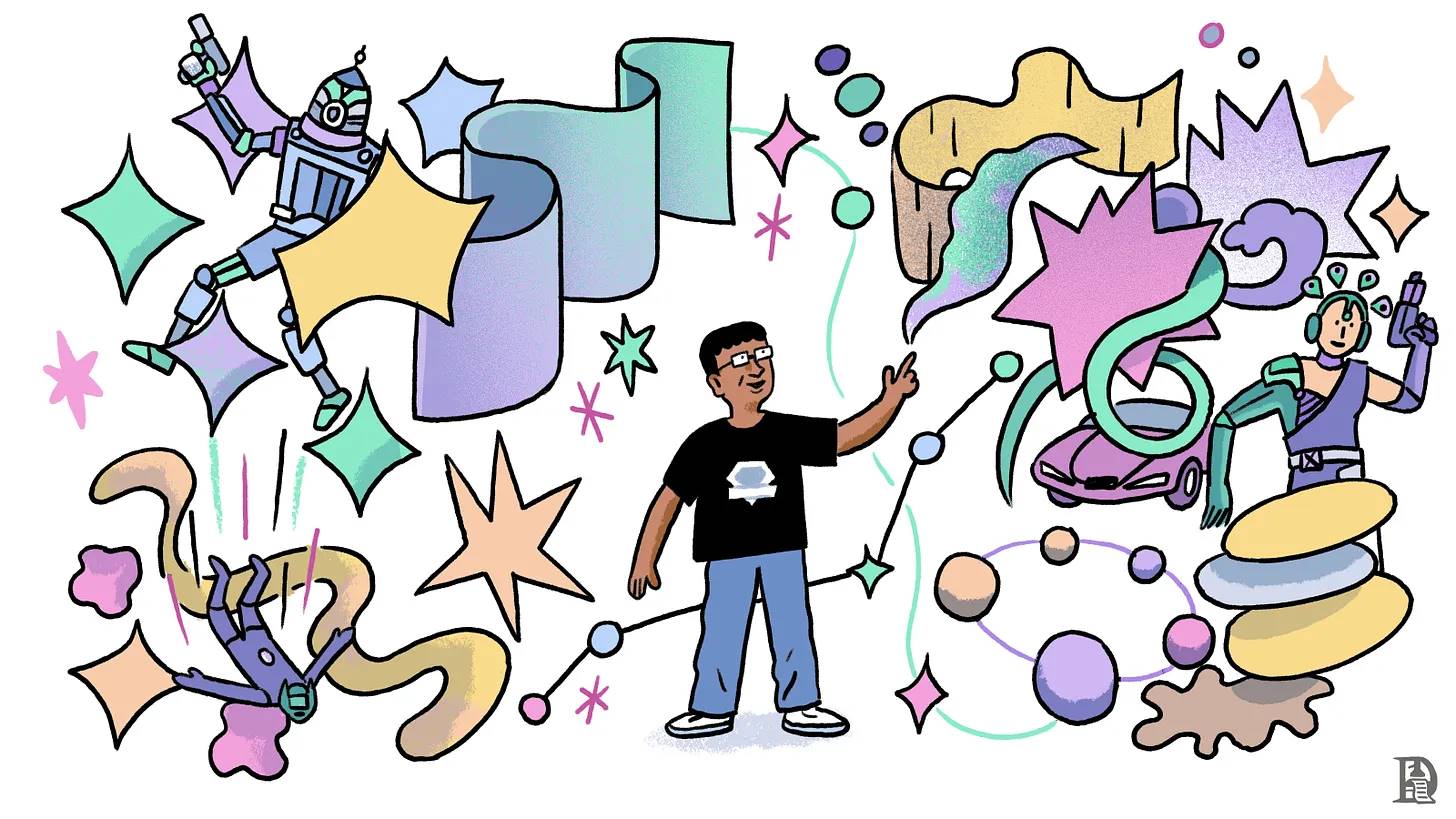
A few weeks ago, I flew back to the city where I grew up, Pune, India. Its home to many tech companies. Far from the heat of Dubai, I was able to enjoy the monsoon there. But the natural beauty wasnt the reason I went there.
I left the office with a simple purpose. I headed to SuperGaming ’s office. We have been an advisor to SuperGaming for over a year. They are one of the largest game publishers in the region with over 100 million active downloads, over 20 games, five of which have over 10 million downloads. Their understanding of the Metaverse is beyond our imagination.
I have been following their CEO Roby John and admire the way he builds the community. Whenever we talk about the product, he always goes into detail about how they are leveraging the community to support what they are building. They don’t have a token or a protocol, just a game that many people love.
So I shadowed him at their offices for two days, during which we discussed in depth his journey as a founder over samosas (Indian fried dumplings) and hot filter coffee. We talked about what it takes to build large-scale communities and why they matter. Here’s a summary of Roby’s more than a decade of experience, condensed into a few thousand words.
For readers in a hurry, the main content of this article is as follows. I will break down how to build a community at each stage.
-
I explained why at the seed stage you should operate under a better-known, more recognizable banner.
-
We explored how engaging with users and making them feel seen and heard can have a huge impact when scaling.
-
I also explain why “culture” is the ultimate challenge a company must face as it grows.
Dont worry, I wont leave you hanging with abstract quotes. For the next 15 minutes, well review Robys 15 years of experience in building companies.
Getting Started
2011. A young idealistic founder from India entered YCombinator. He was no stranger to the world of startups. At 21, he had signed a million-dollar consulting contract during the dot-com bubble, but the process of creating something new was exciting. Roby was developing a game to help users better understand math. They were developing it specifically for the upcoming iOS devices, especially the iPad app.
There wasnt much success in the early stages, but he soon noticed some young users posting videos of his products on YouTube .
This gave Roby an epiphany. This was the period when the founders of Airbnb flew to New York to photograph user listings. The pictures uploaded by users were often not attractive enough, so the founders made an effort to take pictures for the hosts themselves. This made the onboarding process more personalized for the hosts and made the users become trusted advocates. Roby got inspiration from this.
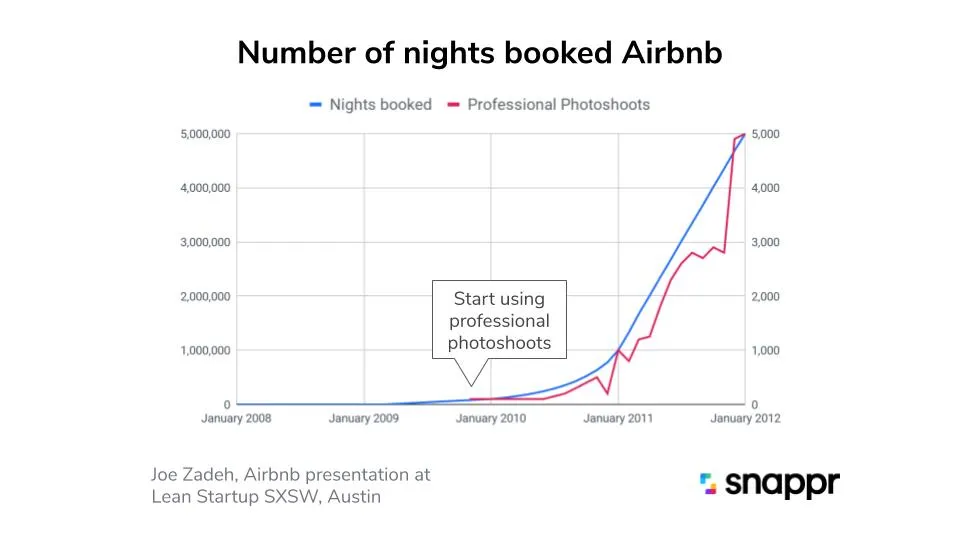
The image above is from the Snappr blog. This article examines the phenomenon in more detail.
He realized that giving users the ability to spread the word about his product would be the difference between its relevance and a quick death, so his focus naturally turned to building community.
If you were a small studio from India, the chances of being recognized immediately were slim. This was before smartphones were common and internet access was not yet widespread around the world. The gaming industry back then was very similar to crypto today, and there was a lot of prejudice against people working in gaming.
So, how do you build a convincing brand?
One way is to go under a more well-known name.
Recognition
In 2012, Roby and his team raised a small $1 million round for what was then called June Software (which eventually merged with Super). Investors included Backflip Studios, a well-known publisher at the time. Working with them opened up Roby’s access to many of the intellectual property (IP) that users loved at the time. It makes sense that users might not specifically search for a particular game studio’s name.
For example, few people would recognize Rockstar Games, but kids often search for terms like “Spider-Man” in hopes of playing games related to their favorite characters. We also saw this with Niantic’s success story in augmented reality (AR) with Pokemon GO. Studios often leverage great IP for user discovery.
So Roby started working with Backflip to develop games like NinJump to acquire users at a very low cost. In the early days, this collaboration helped users discover the games June Software was creating. More importantly, it gave Roby an understanding of how game studios operate. He gained expertise in discovery and operations in one move.
Even today, Super’s platform supports Pac-Man worldwide through a partnership with Bandai Namco, publisher of other titles such as Elden Ring, Tekken, and Dragon Ball, who joined SuperGaming as an investor in 2023.
This has happened before with blockchain protocols. In 2021, joining Polygon means you have access to a wider range of DeFi products moving to that chain. In 2024, building on Solana means you have access to users exploring meme assets. Or on Base, you have access to consumer products.
This is happening right now as the founders launch AVS on EigenLayer. The combination of large brands and operational expertise drives growth when incentives align.
Acting under a larger banner requires founders to go beyond their own capabilities. Large protocols (or brands) don’t need to work with startups unless they can go beyond execution and meet consumer needs. In large companies, small and efficient teams often avoid failures caused by committee decisions. If you are a founder building for a larger brand, consider having proof of concept or research ready to back up your claims.
SuperGaming achieved this by focusing on its core strengths. By 2014, the team had five years of experience building iOS apps and cloud server development. Rather than chasing the hot new trend, they chose to build a multiplayer game for the iPhone over a 3G network.
At the time, people weren’t looking at mobile as the next massively multiplayer medium, but that’s exactly what the team was focused on. This unique entry point helped influence decisions when they talked to large enterprises.
In this case, if you have existing work, most decision makers will be swayed by the time savings. However, writing proposals and navigating internal bureaucratic mazes can get you into trouble. The nuance here is that June Software didn’t find users simply because they partnered with a big brand. You enter these partnerships through business development (BD). They also built a product that users loved.
A great product will work even with average distribution channels, but a mediocre product will not succeed even with great distribution channels. The challenge for operators is to find the middle ground.
In July 2013, Hasbro acquired 70% of Backflip Studios for $112 million. Interestingly, Hasbro owned the intellectual property (IP) rights to Nerf guns. Roby and his team quickly got busy making a Call of Duty-like game for Nerf guns that took advantage of those IPs. Plans for a shooter game based on Nerf guns were subsequently shelved. But it set the stage for the next chapter in their story.
личность
Development of an early version of MaskGun began in 2015. By 2022, the game had nearly 60 million downloads. This success did not happen overnight.
In the early versions of MaskGun, smartphones had low performance. The oldest phone that could run it was an iPhone 3 GS, with a latency of 350 milliseconds (ms). Roby and his team of six decided to name the game MaskGun because they didnt have a 3D animator on the team. If the character wears a mask, theres no need to worry about the characters expression. Its survival in a tough spot, but it works.
After two years of gradual iteration, the product finally reached a higher level of acceptance. At that time, the registration process using Facebook enabled developers to see the users username on the social media platform. Roby would interact with the most active Facebook users at the time and establish a dialogue to help him understand why they spent time playing MaskGun.
He spoke directly to thousands of users to understand why they spent dozens of hours a day in the game. In turn, they shared their stories.

The character with the prosthetic limb is a tribute to an active user of MaskGun.
Some of the stories are quite touching. For example, when one of Roby’s players contacted him with the sad news of his own amputation, he quickly implemented a skin featuring that user in the game. The conversation with the user initially came about with an interest in adding a MaskGun sticker to the prosthetic.
Roby ensures users feel seen and heard within the product.
In another example, he reached out to a player who had spent over $2,000 in the game over five years. Roby wanted to sponsor his favorite bike. These were usually unknown names—not people a marketing manager would consider incentivizing in any form. But Robys focus wasnt on reach or distribution channels.
He focuses on building relationships with the players who spend the most time in the game.
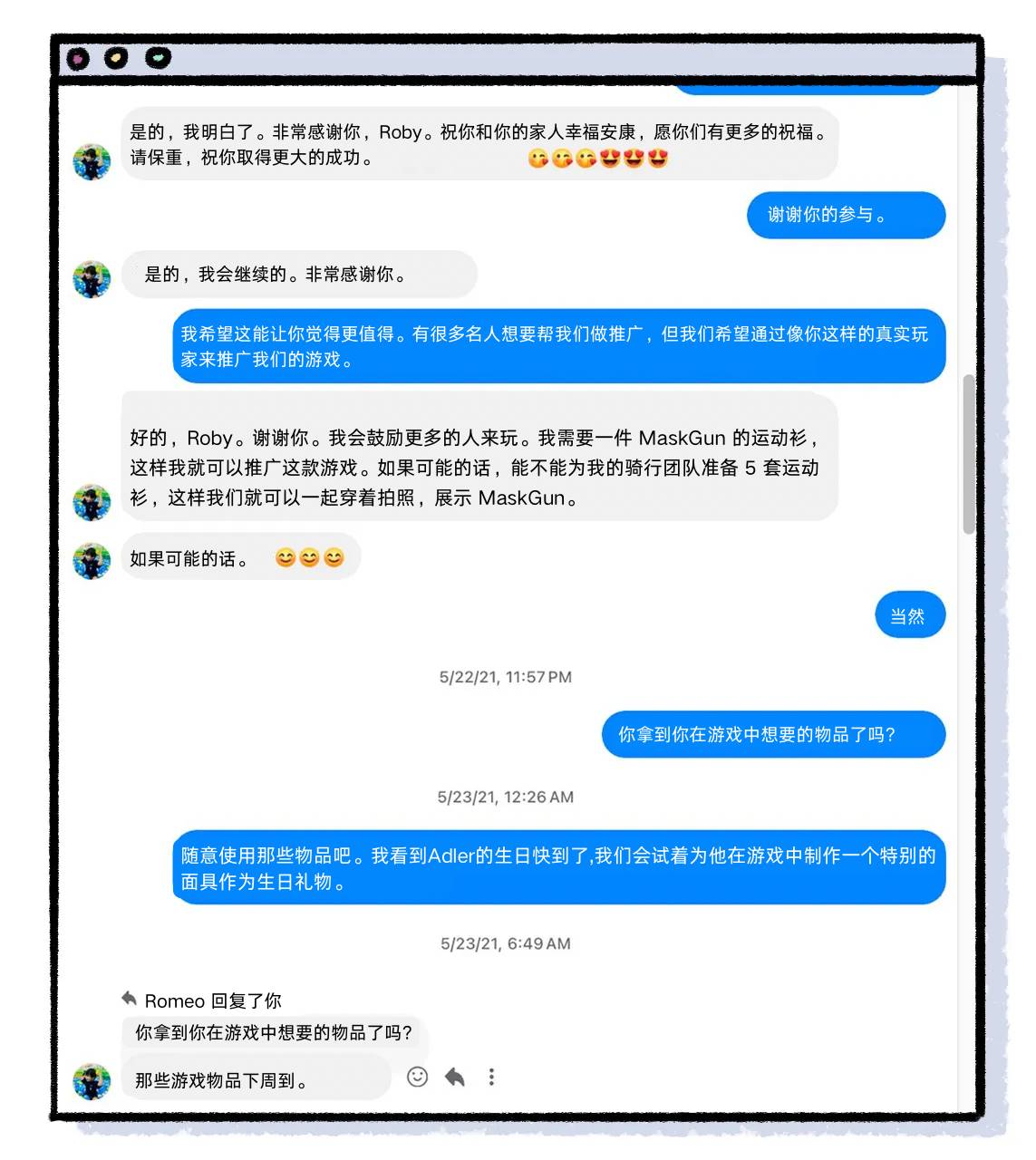
An effective way to build consumer loyalty is to stay in touch with your most active users directly. While this approach cannot be scaled up, it can have a huge impact in retaining core users. The screenshot above shows one of Robys conversations with hundreds of users from his personal Facebook account.
When I was in Roby’s office, he showed me his Facebook account. He had almost a decade of private messages from users asking him for quick bug fixes, asking to have their level down in the game, or updates on their life events. One user even asked Roby to be the legal godfather of his child. These things happen not because marketing managers spend money on distribution, but because founders stay in close contact with their customers. What leads to a better product? Conversations with great venture capitalists (VCs) or interactions with hundreds of users who spend time using your product?
This choice manifested itself in a unique way in the product. At the time, MaskGun was releasing weekly updates, and Roby created in-game characters that portrayed his most active users in some form or another. Roby had his “aha” moment when a user contacted him at 3 a.m., asking for a custom gun skin for a player in his community. The player turned out to be a member of a gang in Australia, and he wanted to express his identity in the game.
Users added gang names to their characters in the game and soon wanted to express themselves through clothing that represented their characters. These requests led to the creation of the in-game рынок.

We see ourselves reflected in the art we engage with most. One way products retain users is by reflecting the spirit that users represent, reflected in their product decisions.
This need for self-expression isn’t limited to games. Often, the products we spend the most time on are those that allow us to express our most authentic selves. Reddit, Instagram, and YouTube all fulfill the human need to be seen and heard. Products like games can’t easily replicate the user base of these social networks. But whenever the user base is large enough, people will want to differentiate or rank themselves.
When developing a product, you can use identity elements in three different forms.
-
Talk to your users and make them feel seen and heard. Invest in their better outcomes. This will help create a critical mass of users.
-
Provide avenues for self-expression so they can interact with the product in a way that connects to their unique identity.
-
When there are enough users, they will be given a ranking mechanism for social status and influence.
Our world may have gone digital, but humans are still social animals, and our need to be seen, recognized, and ranked persists despite changing times.
How does this manifest in Web3? You can observe this in the way Dune emphasizes empowering its users. They have a “wizards” section that makes sure to highlight their most active users. Similarly, Layer 3 also has a leaderboard where users compete to maintain the highest score while using their product. When users are highlighted through a product, they feel a sense of belonging, which in turn helps retain them.
This also works for developers. Dan Romero was famous for scheduling back-to-back 15-minute conference calls with developers interested in joining Farcaster. These conversations made getting started with the original protocol more personal.
Of course, these things don’t scale. At a billion users, the product becomes more apathetic. But there’s another element that can bring users together: culture.
culture
By 2022, MaskGun was approaching 60 million users. It had been in production for nearly eight years, but something was still missing. Between PUBG and Fortnite, the market for shooters had changed dramatically. Roby himself admitted that the product could have gone further in terms of user growth.
A year ago, Roby and a small team of four began talking to users around the office. Within six months, they had meticulously recorded the opinions of 1,000 users. College students, people coming home from get off work, gamers—it was a whole mix. Through these conversations, they captured the psychology of what they were building.
A blank canvas is ready and art needs to be created.
These conversations provide inspiration for the creation of art.
It soon became apparent that despite being a huge gaming market, India had very little representation of users in these games.
In MaskGun, Roby noticed how self-expression helps build a sense of belonging. In NinJump, he noticed the power of intellectual property (IP) in uniting people. In the next chapter, he combined these two ideas, and so their flagship game Indus was born. Its still in early beta, so Ill refrain from mentioning whats unique about Indus itself or why its going to be the next big thing.
What was interesting to me was that Roby started thinking about his product through the lens of intellectual property and self-expression. You combine those two things together, and over time, you have culture.
Culture is the beliefs and expressions we hold together as a society. It doesnt think about individuals, but focuses on what we do as a collective.
When youre individually texting tens of thousands of people to get them on board, its limiting. But distill it into culture and you have a system that can scale. When Apple ran this ad in 1984 , they were transitioning to culture, advocating for the audience to fight Big Brother or this ad, they asked the audience to think differently .
One of my favorite examples of a product becoming culture is sneakers. In terms of their function, all shoes serve the same purpose; they are cushioning for your legs. But add twenty years of manufacturing desire on top of that, connect great stories of athletes, and encourage a parallel market, and suddenly you have sneaker culture . The product transcends the function it serves.
So how do you do that if you don’t have decades to build culture? The answer lies through representation and legend.
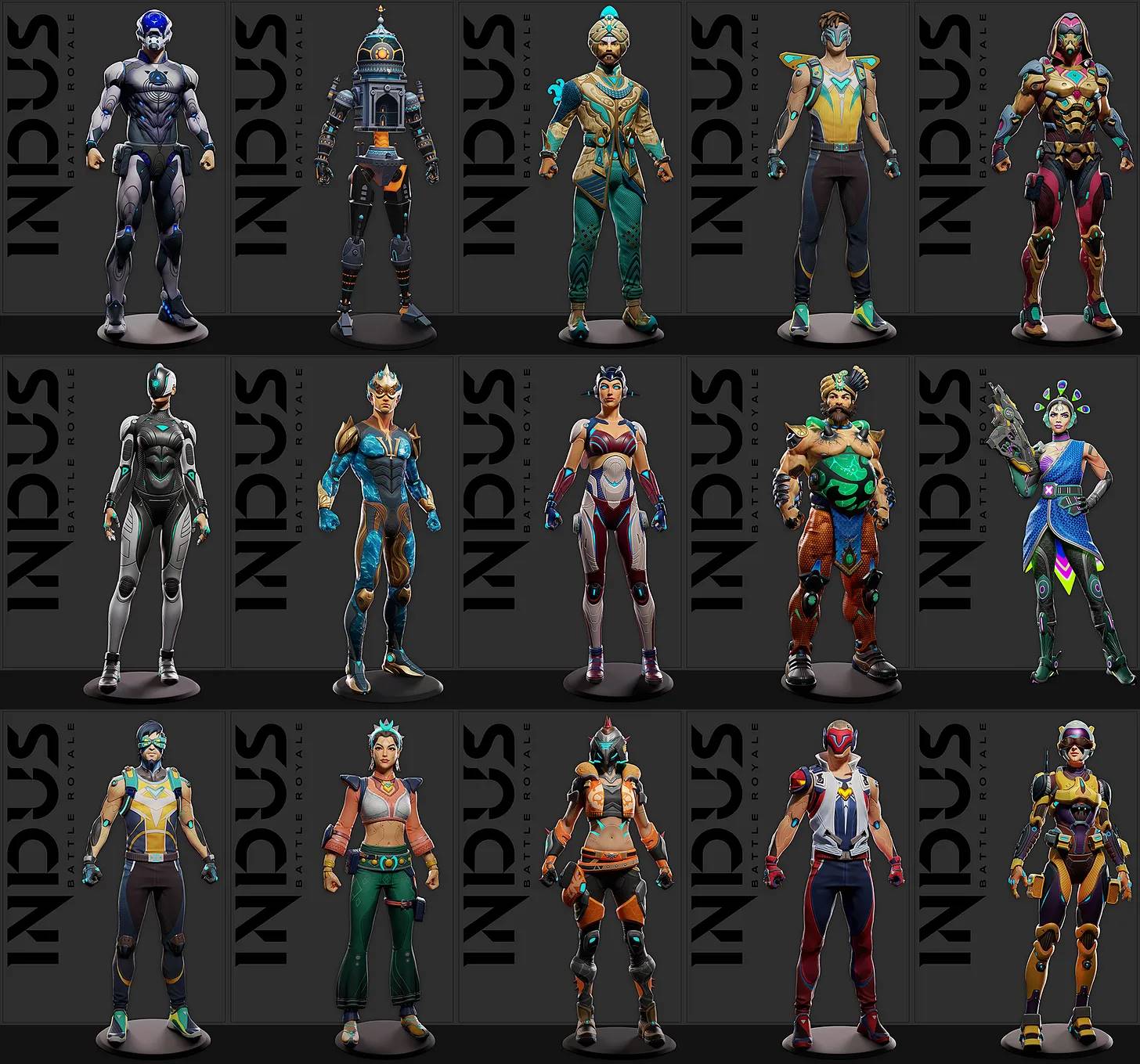
Renderings of characters from the game Indus is developing. Many of these characters are abstract references to local Indian myths and legends.
Indus’ current approach to building culture is by featuring characters and content from India in the game. This can be a double-edged sword. Gameplay that relies on representation alone but lacks depth may not work, but building myths and legends that people can believe in provides a space for users to imagine the product. Before starting to build the game, the team sat down and thought about what Indy futurism might look like.
Through the medium of gaming, the game presents a vision of India’s future, with characters that pay homage to multiple mythological characters that players may have heard of since childhood .
They then combined multiple creator programs to engage the community. In the early stages, most founders built alone in front of the public. Attracting a group of creators to use the product and publicly critique it is equivalent to building a game in front of the public. In fact, the company regularly hires its best creators to join their team and work in the office. Indus also regularly hosts offline events in smaller towns in India, market segments that do not prioritize gaming.
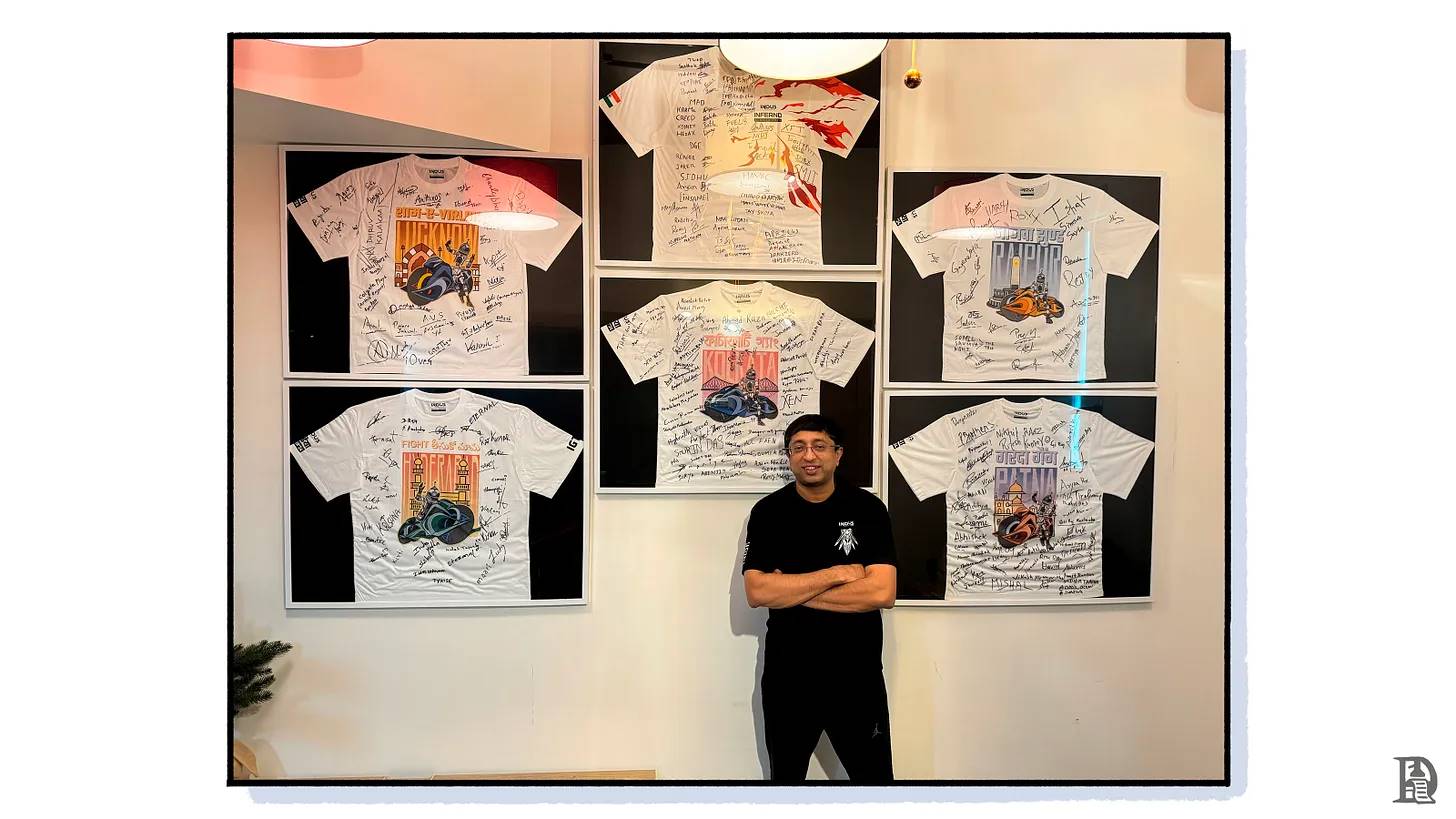
There is a room in the SuperGaming office with these user-signed t-shirts. Each t-shirt is custom designed to represent a town that the SuperGaming team visits when promoting Indus. This gave me a great idea of the target audience of the studio team.
When a brand enters an underserved market, it is able to build lasting loyalty. This strategy helps create distribution channels while collecting critical feedback from users. Naturally, some feedback will be negative. Например, this feedback is a criticism of the games current flaws.
When building a community, you have to be open to criticism and praise. A healthy community is able to have both.
Indus currently works with many of the region’s biggest creators. In fact, Techno Gamerz, one of the region’s biggest video creators, was once a character in one of their games . The studio focuses on building lasting relationships rather than one-off media buys.
Web3 products try to build culture through branding. Our conferences infiltrate the Twitter algorithm for real-life interactions. But we rarely endorse a brand for culture. The closest we have is probably Berachain, who get a ton of attention for the noise they make. At the Token 2049 conference in Dubai, they had an entire drone show и put ads on taxis.
However, when I think about it from the perspective of a game trying to leave a mark, I begin to understand their strategy.
Creators (or researchers) rarely have deep insight into how products are built. As a result, working teams experience fragmented feedback loops and creator incentives suffer. In Web3, it is increasingly clear that paid interactions with creators only occur when financial incentives are involved.
That is, those involved are expected to paint the product (or agreement) in a rosy light. For us to progress, sponsorships need more candor. Creators, without interference, are often capable of producing far better work than most marketing managers can cobble together. But as an industry, we are not there yet.
Digital Third Space
While writing this story, I realized that the Metaverse isn’t some distant future concept, but already exists in the games we play and the platforms we spend our time on. Twitter is a third place. So is Telegram. For some people, Uber Eats might be, too. But not all of these platforms are replacements for the third places we used to frequent, or fulfill the functions they once did.
One of the main reasons for the rise in depression is the lack of a third place . Historically, the village square, cafe or playground have been where we spent time. As interactions move online, we need new town squares. Games are increasingly filling this gap. Many Super users use their intellectual property for self-expression and identity.
In the analog world, people used religion and politics as mechanisms for identity . In the digital world, we will use our online presence and the worlds we spend our time in as extensions of our identity.
So how can founders take advantage of this? It comes down to four core elements:
-
Build adequate distribution channels by partnering with established brands. If you’re a small startup, partnering with brands (or creators) that are well-positioned in your target niche is your best option.
-
Allowing users to feel seen and heard provides a mechanism for capturing feedback in shorter feedback cycles.
-
Create a culture by following a set of values and have the product reflect those values.
Today, people buy not products but stories and people associated with them. For example, Bored Apes are hot in 2021, in part because of the many celebrity endorsements . Owning a Bored Ape lets you show that you own the same asset as Jay Z. In 2024, owning a Bored Ape could mean being in great trouble because its price has dropped significantly.
To nurture and spread stories, you need community, and that doesn’t happen inorganically overnight. For Roby, it was a decade-long process. For some of the deals we work on, it’s been an average of 3 to 4 years.
Strong communities need great products that act as unifiers. Users miss products that are taken down. Think about how we panic when Twitter or WhatsApp go down.
Some games in the SuperGaming catalog have been sustained because 20 users are still playing them years after updates were released. Whether it was NinJump in 2014 or MaskGun in 2022, Supers focus has always been on quality products that are constantly iterating. Our observation is that quality products create active communities.
When leveraged correctly, it helps create a flywheel that retains users longer, while giving teams a competitive advantage in terms of building. MaskGun has grown organically to 90 million players to date, and Indus has 12 million pre-registrations. The former hasn’t had any game updates in the past year, but still has 50,000 new users signing up every day. That’s the advantage of a healthy community.
Ultimately, investing in community and curating atmosphere isn’t just about delighting people, it’s about investing in user retention and consumer feedback in an organic, authentic, and brand-true mechanism. When Roby started the community in the early 2010s, the goal was to get organic word-of-mouth for his product. Over the course of the decade, he realized that a healthy community is one that fosters interaction between users.
People come for the product, but stay for other users. The culture that a product drives determines how users interact with each other. This is why we see very different user behaviors on different platforms. Whether it’s 4chan, TikTok, or Instagram, the underlying culture defines the community. Part of a founder’s job is to help drive the culture in the desired direction.
We all shape worlds through the products we build. Communities make those worlds livable and make those who come to them feel less alone.
This article is sourced from the internet: How should startups build a growth flywheel from product to community?
Related: 2024 Crypto Market Q2 Review: Total Market Value Shrinks by 14.4%, MEME Remains Popular
Original author: CoinGecko Original translation: 1912212.eth, Foresight News After nearly breaking all-time highs in the first quarter of 2024, the total cryptocurrency market capitalization gave up some of its gains in the second quarter, falling 14.4% to close at $2.43 trillion in June. Total cryptocurrency market capitalization fell 14.4% in Q2 As of Q2 2024, the crypto market cap was $2.43 trillion, lagging behind the SP 500鈥檚 3.9% gain. Volatility in cryptocurrencies remained high in the second quarter, with volatility at 48.2% for Bitcoin, 46.7% for BTC, and 12.7% for the SP 500. Bitcoin price at the end of Q2 is $62,734 BTC fell 11.9% at the end of the second quarter, and the impact of the fourth halving is currently minimal. The transfer of 140,000 BTC by Mt. Gox…







